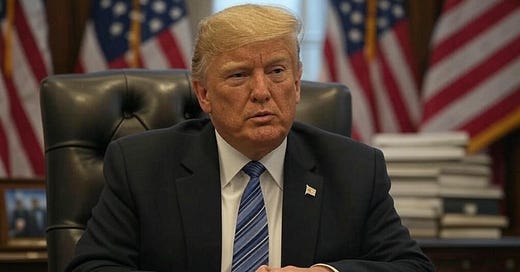To Investors,
The last 12 or so days have been wild. Trump’s Liberation Day tariff announcement shook everyone. Global stock markets were down, then went back up, tensions were high as some national leaders felt the need to announce retaliatory tariffs, and other leaders such as the Vietnamese President and President of the European Commission quickly jumped right to suggesting zero tariffs for the U.S. in order to express their desire for a trade deal.
On April 9th, President Trump announced a temporary pause to the tariffs for countries that did not retaliate to his initial tariff announcements. I think this was calculated and by no means a sign of Trump caving because in my view the Liberation Day event was a negotiating tactic, and where we go now is exactly what Trump has been saying he wanted to do for years, which is to reshape the global trading order.
What do I mean by that?
Well, I’m unable to confirm this, but I have a theory that the U.S. ended up with trade deficits initially by design as a way to expand U.S. influence globally. After Nixon announced the end of the Bretton Woods agreement and declared that gold would no longer be exchangeable for dollars, the United States was the only superpower in the world, and to maintain that status they used the U.S. dollar to help developing economies grow and industrialise, while attracting demand for U.S. dollars and cementing dollar dependency through exporting U.S. government bonds as a reserve asset.
I would argue that a strong dollar led to a higher standard of living in the U.S. but through a series of compounding events such as the Vietnam war, the Cold War, the Global Financial Crisis, then more recently with Covid, the U.S. trade deficits became more and more unsustainable because the U.S. ended up having to continuously fund trade settlements using debt, at the same time as carrying the burden of being a provider of reserve assets, which contributed to U.S. national debt reaching 123% of GDP as of 2024, and 10Y U.S. government bond yields reaching an uncomfortable level at around 4-5%, which means higher refinancing costs for the U.S. which would significantly add to the growing national debt.
Stacked on top of that problem, while the U.S. fiscal status was taking a bad turn, China was able to grow into its own superpower, supported by its low cost exports model, and ever growing trade surpluses.
As a legitimate superpower China is now seen as a threat to the United States, the U.S. dollar, and to the dollar as a reserve asset, and the U.S. 's hold on global security. This is what various commentators are saying and I agree with the security threat in terms of China expanding influence and the threat of China’s growth on domestic U.S. industrial capacity; but I disagree with the idea of China threatening the U.S. dollar.
After the announced 90 day pause on tariff implementation I think that we’re going to see most of the world’s leaders come to the table to make an agreement with the U.S. and the agreement will likely be world-changing, something like the initial Bretton Woods Agreement. These new negotiations will be called the Mar-a-Lago Accords; a gathering of global leaders to pen a new world order that will be America first (once again) similar to the Bretton Woods agreement.
The Mar-a-Lago Accords will be a reinforcing of United States self-sufficiency as well as U.S.and U.S. dollar hegemony. So a series of deals will be struck and I’ve broken down some suggestions of what I think will be the 3 key themes of the Accords, and what might shape the deal points within each theme…
1. Reorganising Supply Chains Away From Foreign Dependency:
There are three key supply chains that the U.S. will likely want to secure to ensure self-sufficiency.
The first is pharmaceuticals and medical equipment; because during the COVID-19 pandemic, according to Grok, top U.S. medical equipment firms like 3M, Medtronic, and Becton Dickinson struggled to scale PPE production due to reliance on overseas supply chains, raw material shortages, and regulatory hurdles. Pre-crisis, the U.S. imported nearly half its PPE from China, which dominates global production with firms like Winner Medical, BYD, and Powecom. When China prioritised its domestic needs and restricted exports, U.S. stockpiles dwindled, exposing a critical dependency. Despite domestic efforts–e.g., 3M quadrupling N95 output–the U.S. leaned heavily on Chinese imports to bridge the gap. This vulnerability underscored the risks of non-U.S. reliance, and this is fuelling a strategic shift to re-shore manufacturing in the pharmaceutical and medical equipment space because the U.S. can never come across as vulnerable in that way again.
The second supply chain is the rare earths supply chain. Right now China has 90% of the rare earth industry supply chain, from minerals to finished goods. With the continued global efforts towards electrification, one important component that electric vehicles rely on are rotors which make the car move, and these rotors are spun using permanent magnets. Wind turbines that generate wind energy have them as well, and so do drones. These permanent magnets are manufactured using rare earth minerals, the most important of them being neodymium and praseodymium. The only mining company outside of China that has capacity to supply a significant amount of rare earths is MP Materials, a U.S. based company that recently was bought out of bankruptcy, but has quickly grown to restart its mining and production processes, and after investing in a U.S. based permanent magnet manufacturing plant, MP Materials is expected to start deliveries of its first permanent magnets in 2025. According to the chart below from Boston Consulting, outside of the U.S., China, and Australia, “upstream activities are mainly in Myanmar, midstream activities are mainly in Malaysia. In both instances, rare earths are primarily mined by Chinese companies.”
In another chart, 72% of rare earth imports into the United States between 2019 and 2022 were from China. That’s a deep vulnerability.
Being the only supplier in the U.S., MP Materials has long been flagged as a U.S. national project, because again, the U.S. does not want to come across as vulnerable in any supply chain.
The third critical supply chain that may be included in these Mar-a-Lago Accords is related to United States energy. Right now OPEC controls more than two thirds of global oil supply, and together with Russia, they largely impact the productivity of the world through oil supply and prices.
According to Perplexity, in 2021 Russia supplied 45% of the EU's natural gas imports, with Germany and Italy being the largest importers. In 2024, that number fell and Russia accounted for less than 19% of the EU's total gas imports, however those countries are in an energy deficit, so it's not as though they’ve necessarily replaced the Russia-dependent supply chain. This cannot continue to be the status quo for the U.S., where an allied region depends on energy from a non-ally.
So in short, as a deal point in the Mar-a-Lago Accords under a theme of reorganising supply chains away from foreign dependency, countries will be mandated to lend expertise and capital to build a pharmaceutical and medical equipment supply chain coming of the U.S., support companies such as MP Materials and related businesses to build a rare earths supply chain coming out of the U.S., and buy United States oil and gas outputs – if the country wants to avoid tariffs and become part of the United States economic and security umbrella.
2. Reinforcing U.S. Dollar Supremacy:
Many people tend to look at China’s holding of U.S. treasuries (going from ~$1 trillion in June 2020 to ~$774 billion in June 2024), as well as more recently China’s gold purchases that are suddenly big news, as some sort of sign that the U.S. and U.S. dollar are in trouble if one of the world’s largest holders is selling treasuries and buying gold. I think there’s no such sign. I think it's more plausible that China is selling U.S. treasuries to support their own currency. China is in a growing national debt environment, with their property market (which makes up 20-30% of the GDP) reportedly in crippling debt, so propping up the yuan may make sense to try to generate more revenue for their exports market – comforted by the fact that a lot of the world are dependent on Chinese goods anyway so there’s nothing we can do except eat the higher prices.
On top of that, China has a pattern of buying gold every 6 or 7 years or so, therefore I don’t think there’s a hidden signal there.
Additionally, one of the main reasons why it makes sense to hold U.S. treasuries in an environment where the U.S. dollar is the global trading currency is to have access to U.S. dollars by having the option to sell treasuries in order to get more dollars to settle trades. But China is a net exporter with large trade surpluses so they don’t need to hold large amounts to U.S. treasuries to settle trades because they sell more than they buy anyway. So in this Mar-a-Lago Accords theme of Reinforcing U.S. Dollar Supremacy, the idea is geared more towards the United States being able to manoeuvre the dollar to support a U.S. export economy at the same time as having a relatively stronger currency, as well as being able to finance domestic growth through longer term commitments such as longer duration bonds.
I’ve also seen media publications and other comments that the yuan will replace the dollar as a global trading currency or reserve currency.
For the record, there is no alternative to the U.S. dollar as a reserve asset and global trading currency. Because if a currency will be used as medium to settle global trades, it must also then be valuable to hold as a reserve asset. The reason being that, as I alluded to earlier, regular access to that currency is a requirement for payments, so it would be expensive to continuously go out into the market to buy the currency because you’re then vulnerable to exchange rate volatility. So countries hold the trading currency in reserve because it helps them secure a long term price. At the same time, countries hold that currency not as cash but as a government bond, so the country also then collects income via interest on that government bond.
Putting aside the fact that the yield on a Chinese 10Y government bond is floating around 1.65% vs 4.49% for U.S. government bonds.
There are two conditions for a currency to be acceptable as a reserve currency. One condition is that you must be open to sharing financial information with the buyers and potential buyers of your reserve assets. In this case the U.S. must always have transparent and open financial markets and be willing to share national fiscal data to any party that wishes to buy U.S. government bonds. That also includes a free and open financial system that permits free capital flows and true market discovery based on public scrutiny and analysis. China certainly does not satisfy this condition because China has a relatively opaque and closed economy with intense capital controls.
The second condition for a currency to be acceptable as a reserve currency is that there must be a governing rule of law that guarantees that your investment in a country’s assets is protected and won’t be stripped away at the whim of anyone. It’s no secret that there is no such rule of law in China. Because of the lack of rule of law, and the lack of financial transparency inherent in the Chinese economy, forget about the Chinese yuan even being an option to replace the U.S. dollar as the global reserve and trading currency. Would you lend a business person that operates in China your money at the risk of not being sure if they 1) have the financial means to repay your loan, or 2) can just say “no actually we’re good, we’re keeping this money. Sorry!”?
So that deals with the “Yuan replacing the U.S. dollar” argument. Again, there is no other option outside of the U.S. dollar, so I think this is significant leverage for the U.S. and they will play it by floating the idea of a security umbrella. This is an idea mentioned by Stephen Miran, but I’m using it here to explain it in my own words so that I can test my understanding of the idea.
A security umbrella in this context is physical and financial security that the United States offers allied countries. These are countries that are in NATO as a military alliance, and other countries that are large holders and purchasers of U.S. treasuries, including those that aren’t floating the idea of “replacing” the U.S. dollar for trade settlements.
The aim of this security umbrella will be to encourage interested parties to partner with the U.S. to 1) reshape global supply chains away from non-allies (away from OPEC oil dependency, away from Russian gas dependency, away from Chinese dependency on critical medical and mineral resources); and 2) buy U.S. treasuries, perhaps even century bonds (100 year bonds) so that the U.S. can secure lower yields; and in exchange the U.S. will remove tariffs for the purchasing nation, and most importantly open U.S. dollar swap lines with the purchasing nation. Now that does three things:
A century bond is a less liquid investment than a 3 or 10 year government bond so to alleviate the worry of the lowered liquidity, swap lines will play a significant role because they ensure that a country looking to access U.S. dollars can do so at more favourable rates than open market rates.
The swap lines protect the buying nation’s own currency as they won’t have to sell large amounts of their own currency to access more and more dollars if the U.S. dollar appreciates.
In the context of these Accords, if the negotiating party agrees to purchase century bonds, that locks in a partnership to help rebuild the U.S. as mentioned earlier.
Trump has also complained that the U.S. disproportionately pays for NATO membership requirements while the U.S. supplies the most reliable security. He’s mentioned that the U.S. should be paying less and offered that member countries pay more as a percentage of their respective GDPs. As another deal point in this section of the Accords, Trump may offer to continue paying for NATO at the current proportion, or offer to pay more, on the condition that member countries continue to buy U.S. treasuries or buy at a higher rate–perhaps even the suggested century bond.
It's important that demand for U.S. treasuries remains strong because it reduces the yield on the bond, meaning that the U.S. can continue to issue debt at a more favourable rate for themselves, and it also reinforces the U.S dollar as a global reserve currency in so far that the security umbrella is of interest to the world. Altogether the increased purchases in U.S. assets support the U.S economy, and this brings in the third theme of the Mar-a-Lago Accords… Reorganising Trade Flows.
3. Reorganising Trade Flows
The United States has a $123 billion trade deficit which has largely come as a cost of a combination of a stronger dollar, exporting reserve assets via U.S. government bonds, and the U.S. trying to expand its influence by agreeing to trade with developing economies on deficit. That deficit is also a marker of how the U.S. domestic industrial economy is not as productive as they would like, because if you have the strongest currency in the world in exchange rate terms you’d easily be able to import more but at the same time your exports are more expensive so you export less. I think that while efforts are focusing on reducing the trade deficit, the U.S. will not be able to eliminate their trade deficit, nor should they want to completely eliminate it. Instead, as mentioned above, the larger project is reinforcing United States hegemony, so in combination with the ideas discussed above, I think “squeezing out China” will be the subtext of a lot of the Mar-a-Lago Accords. So while the U.S. places 145% tariffs on China, the U.S. will also want the rest of the world to reorganise its trade flows by buying from the U.S. to replace China in certain industries.
Using the U.S. dollar and the U.S. security umbrella as leverage will enable the U.S. to focus on critical factors that I think will make the U.S. the most powerful and once-again self-sufficient country. I’ve mentioned pharmaceuticals and medical supplies, rare earths, and energy as 3 key supply chains that the U.S will want to ensure they are self sufficient in—there will be more that will be touted as important—but these three are key.
But while the U.S. may not outright eliminate its trade deficits, an additional deal point that I think will be included in the Accords may be that the U.S. says “we’ll keep the trade deficit, but we want access to your mineral resources”. This isn’t a far-fetched idea because we saw that one of the reasons that Trump wanted to buy Greenland was for their mineral resources, and it was mentioned that in order to continue assisting the Ukraine, there was a condition in a recent proposed agreement that Ukraine give the U.S. access to mineral resources.
It's also important to mention that the U.S. is one of the best technology exporters in the world. The iPhone you’re reading this on, the streaming platform you watched your favorite series on (Disney/Netflix/YouTube), the platform that allowed me to send an email to a colleague (Microsoft Outlook), the search engine you used to learn more information (Google, Perplexity, Chat GPT, Grok, Bing) — all American companies. The Mar-a-Lago Accords will therefore not leave out the opportunity to perpetuate U.S. technology dominance and I think AI and Crypto will be key points that will be included in these Accords, but I give special mention to AI and crypto in a separate section because these are nascent industries that aren’t yet understood well by most of us.
AI has demonstrable and unprecedented potential to change all of our lives in an incredible way, from finding new chemistry for medicines, or battery components, or energy chemistry for nuclear power, or developing biotechnology products, or being able to diagnose a medical query. AI infrastructure will therefore be a major talking point. Already the U.S. prohibits NVIDIA for example from exporting its latest and most powerful GPUs to China, because of this idea. The Accords will therefore likely include a deal point where all countries must ensure to buy AI equipment from the U.S., and at the same time support building GPU manufacturing capability in the U.S. because the best chip manufacturer in the world is in Taiwan, and it’ll be a very tricky situation for the U.S. if China decides to invade Taiwan to gain control of chip manufacturer TSMC.
Crypto also has the ability to reshape financial flows, currency estimated at $1.3 trillion in value. Stablecoins will be discussed to reduce friction that’s hard to deal with in the current SWIFT financial system. There will also likely be discussions about supporting other U.S. born crypto projects. The tell sign was the recent announcement of a U.S. strategic bitcoin and crypto reserve.
All of this being said, the Mar-a-Lago Accords won’t be easy to finalise. There are too many moving parts in any single economy, but orders of magnitude more moving parts in multilateral trade, so I have a number of unanswered questions that will likely be answered as time goes by and we see things unfold.
Unanswered Questions
I saw a video of Morris Chang, founder of TSMC, mentioning that it would be near impossible for GPU manufacturing to take place in the U.S. because there aren’t enough workers in the U.S. with the skills to support that complex operation. Apple CEO Tim Cook made a similar argument in a more recent video when he was explaining why Apple keeps its manufacturing for iPhones running through China. It will be a large task to re-shore that high technology manufacturing to the U.S. How will this play out?
Low cost manufacturing likely can’t take place in the U.S. because of wages. Things like fast fashion apparel and shoes may not make sense to manufacture in the U.S. but the U.S. is probably not looking for that type of manufacturing productivity, but probably rather looking to champion companies in aerospace like SpaceX, Relativity Space or Blue origin; companies in Advanced Aircraft like Boeing or Lockheed; companies in defense-tech like Anduril; and other companies perhaps in the broader technology space, noting that a lot of the world’s greatest tech businesses are concentrated in the U.S. How will this play out?
One final problem is that the communication could probably be better from President Trump himself. His head of Treasury, Scott Bessent, and his head of Commerce, Howard Lutnick, have given great interviews on Trump's trade policy but those have made less rounds in the media vs other talking heads commenting on the U.S. trade policy that’s currently taking shape. The 90 day pause on tariffs was likely always part of the plan to signal that Trump is open to negotiating, but again we all like certainty and clarity on major issues, so will his communication improve?
Wrapping Up
This must be what it felt like in the 1970s when Nixon made his announcement on the end of the Bretton Woods agreement. Markets probably went crazy, a lot of uncertainty may have been circulating, but it was likely quite exciting to have a lot of world changing information coming at you and having to decipher what it all means, especially as a capital allocator.
I’m looking forward to seeing how the Mar-a-Lago Accords play out, (perhaps they may even really be called that!), and I’m particularly looking forward to seeing how the trade terms play out particularly with regards to reorganising trade flows and seeing how the U.S. builds and supports the three critical supply chains relating to pharmaceuticals and medical equipment, rare earths, and U.S. energy. If these key supply chains can be built up in an organised way however,I think that the rest of the themes and deal points will fall into place on their own. What a time!
On my journey to becoming a master capital allocator, one lesson down, a billion more to go.
Hope you all have a great day
-Mansa


















Share this post